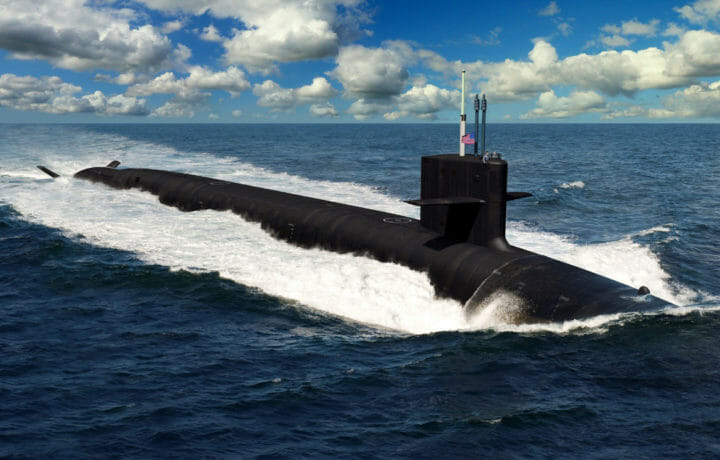It was a year ago that the American Marine Machinery Association gathered to listen to Edward Bartlett, the founder and CEO of Bartlett Maritime, voice his concerns about the nation’s submarine capability shortfall. The White House responded by releasing a supplemental budget request that included $3.4 billion to support the submarine industrial base as part of a larger $50 billion package that also includes additional military aid to Ukraine and humanitarian support for Israelis and Palestinians.
This month, the U.S. Navy announced a partnership with private industry to further grow the submarine industrial base capacity. As part of Navy Secretary Carlos Del Toro’s Maritime Statecraft initiative, it includes rebuilding the manufacturing base that has shrunk to just one-third of its capacity from only 30 years ago.
The sea service is calling for submarine production to nearly double, requiring an additional 3.5 to 4.5 million submarine module production and outfitting hours annually.
“This partnership will play a key role in ensuring submarine shipbuilders can meet the Navy’s required sustained submarine construction cadence for the Columbia Class and Virginia Class submarine programs,” the U.S. Navy stated.
Private Equity In the Government Sector
The initiative is calling for private investment towards the expansion of domestic shipyard capacity for submarine module manufacturing. That has included an investment by Austal USA, which will be used to fund the acquisition and development of the Alabama Shipyard in Mobile.
“This Gulf Coast site, with its deep-water port, advanced facilities, and proximity to significant infrastructure and a skilled workforce, is ideally suited for expanding industrial base capacity,” the U.S. Navy explained, noting that it is also positioned next to Austal USA’s facility and can support the production of the Columbia-class and Virginia-class submarine modules, and also provide additive manufacturing and even training.
“[This] announcement underscores our commitment to finding innovative and creative solutions to accelerate submarine production and is emblematic of my Maritime Statecraft initiative that seeks to incentivize expansion of our national shipbuilding capacity by engaging new, forward-leaning stakeholders and leveraging the power of public and private investment,” said Secretary of the Navy Del Toro.
The secretary added that it would answer his call for private investment into small-to-medium-size shipyards, both active and dormant.
Those facilities “were previously the backbone of our Nation’s maritime power, and I look forward to continuing to work with industry on future initiatives to strengthen our maritime industrial base,” Del Toro explained.
Go Fund It
Financing for the effort included the private equity-backed United Submarine Alliance (USA) Qualified Opportunity Fund LP (the USA Fund) acquiring the assets of the 355-acre Alabama Shipyard. The facility will prioritize U.S. Navy maritime infrastructure investments and sustainment activities to develop an additional 75% of the site to support submarine production, workforce training, and industrial capacity, including facilities aimed at serving unemployed and underserved communities.
“These efforts will significantly boost the capacity of the submarine industrial base while enhancing workforce training, recruitment, and retention across the entire Gulf Coast,” the Navy added. “The agreement includes contractual mechanisms that support Navy oversight and authorities to safeguard Navy and national security interests. The project is expected to create approximately 3,000 new, sustainable jobs while preserving all current employment at the shipyard.”
USNI reported that the USA fund is currently managed by Connecticut-based CapZone Impact Investments LLC., an investment group that was started in 2018 to invest in federal opportunity zones. That was a year after the U.S. government created opportunity zones, the census tracts that were identified as economically distressed, according to the IRS.
“This incentive’s purpose is to spur economic development and job creation in distressed communities by providing tax benefits to investors,” the IRS explained.
History of the Alabama Shipyard
The facility was first established as the Alabama Drydock and Shipbuilding Company (ADDSCO) just prior to America’s entry into the First World War. The facility went on to play a significant role in the Second World War, with its more than 30,000 workers constructing and maintaining vessels for the U.S. Navy. During the war, it was the largest employer in southern Alabama.
It closed in the 1970s due to declining business and labor unrest but later reopened. In 2019, Alabama Shipyard became the owner. It remains the largest shipyard in Mobile, while the expansion is expected to create around 1,000 new jobs at Austal USA.
“By revitalizing infrastructure supporting the maritime industrial base to enable increased production capacity, the Alabama Shipyard investment supports the U.S. Navy’s continued maritime dominance, enhances strategic deterrence, and protects the nation’s interests well into the future,” the sea service added.



